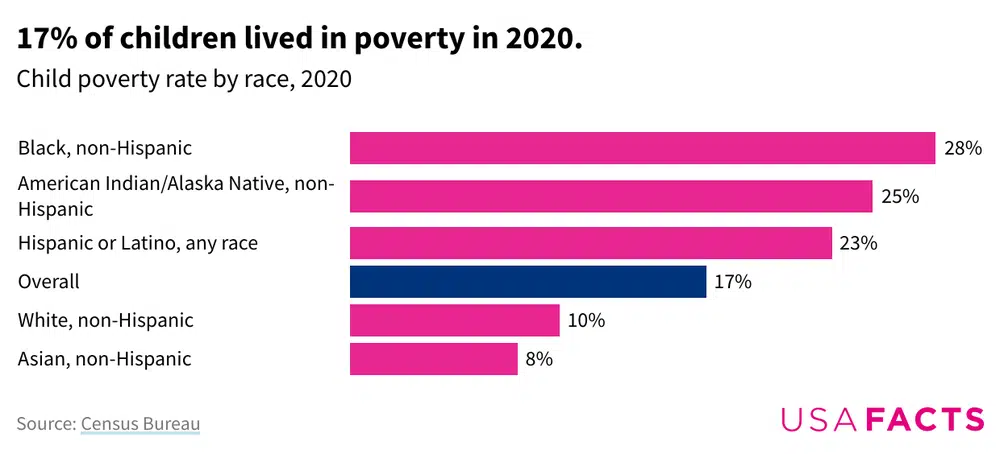Are more or less US children living in poverty? Are more or less kids in foster care? Is child abuse declining? Recent USAFacts' analysis reveals insight into questions about children’s quality of life and the governmental measures to support children living in poverty. Here are some key indicators of child welfare in the US:
Child poverty declined in the past decade
Of all people living in poverty in the US, a third (or 11.8 million) are children, as of 2020. The number of children in poverty declined 28% between 2010 and 2020. The lowest child poverty rate of the decade occurred in 2019.
The number of kids living in poverty changes for different races and ethnic groups. In 2020, non-Hispanic Black kids had the highest poverty rate at 28%, compared to a quarter of all American Indian and Alaska Native kids. Hispanic children followed closely behind with 23% of youth living in poverty. White and Asian kids have lower poverty rates, with 10% or less living in poverty in 2020.

Homelessness is on the rise
While declining child poverty rates indicate improving quality of life for kids, the number of homeless kids enrolled in school paints a different picture. At least 1.28 million children enrolled in school were homeless in 2020, down from 1.38 million in 2019.
The number of unhoused children enrolled in school (and known to the government) increased 37% between 2010 and 2020. Data from 2020 shows that more than three-fourths of homeless kids were living “doubled up,” meaning they lived with others due to loss of housing, economic hardship, or a similar reason. About 11% of homeless kids slept at shelters and in transitional housing, including kids awaiting foster care.
How many kids are in foster care?
The number of children in foster care and their median stay in foster care have increased over the past decade. Child neglect was the primary cause of children ending up in foster care in 2020 (64%). Having a parent suffering from drug addiction was the second leading cause of kids in the foster care system at 35%.
At the year-end of 2020, over 407,000 kids were in the foster care system, a slight decrease from the previous year.
Child abuse is declining
Child victims of abuse and neglect are most commonly hurt by their own parents. This number has decreased over the past decade across most demographics, except for girls, kids ages birth to one, and Hispanic children.
Child fatalities as a result of reported abuse/neglect increased over the past decade. Increased fatality rates were seen in children of all age groups. By race and ethnicity, the percentage of fatalities that were non-Hispanic white and Hispanic children decreased, while those among Black children increased.
Black children are disproportionately harmed by maltreatment. Even though Black kids make up only 14% of the US child population, in 2019, they were 35% of kids killed by maltreatment and 21% of children experiencing abuse or neglect.
What government programs help children’s well-being?
The US government has several programs aimed at supporting the well-being of children. These programs are designed to help children in various areas of their lives, such as education, health, and safety. The Supplemental Nutritional Assistance Program, also known as food stamps, is the government’s largest nutrition benefit program. The National School Lunch Program provides free and reduced-price lunches to low-income school children. These are two programs aimed at supporting children living in poverty who may be experiencing food insecurity.
The Children’s Health Insurance Program (CHIP) provides low-cost health coverage to children in families that earn too much money to qualify for Medicaid but not enough to buy private insurance. As of 2020, over 9 million kids were enrolled in the program.
The Head Start program provides early childhood education and parent-involvement services to low-income families. The program also serves children in foster care and children experiencing homelessness. There were 825,501 enrollments in Head Start in 2020, a slight decrease from the previous year.
More about the government 10-K
Each year, USAFacts compiles information on key metrics, risk factors, and finances for the US federal, state, and local governments. We report a summary of these metrics — similarly to how US public companies file an annual 10-K report. This annual USAFacts Government 10-K is a central source for a full accounting of the results of the programs the government enacts, cuts, and extends.
This 10-K combines data from more than 90,000 different government entities. Due to the slow nature of government reporting, the state and local financial data is three years old, covering data from 2010 to 2020.
Learn more about the standard of living and child poverty programs. Get the data directly in your inbox by subscribing to our newsletter.







